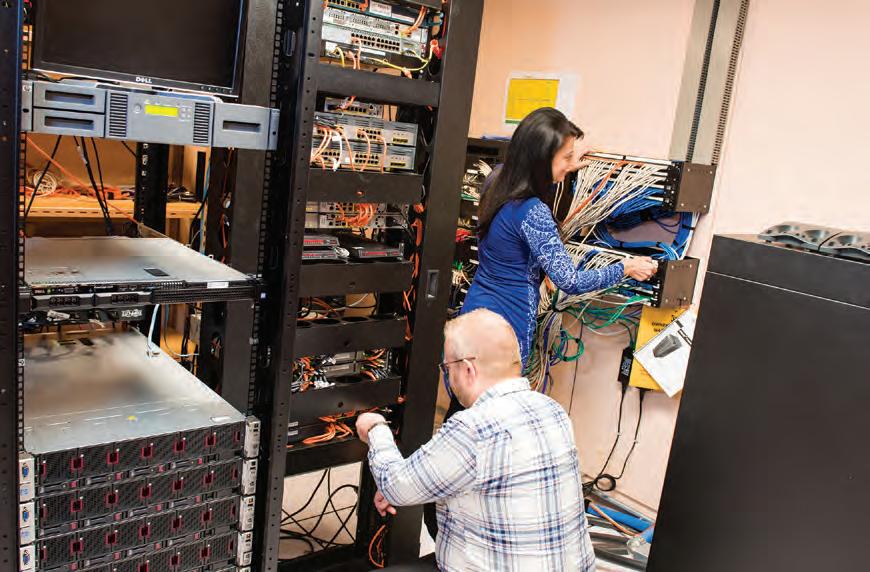
5 minute read
Support Services
In order to meet the Regional Board’s four Strategic Priorities, there are a number of areas within the RDCO organization that are needed to move those objectives forward. Staff in departments such as Corporate Services, Financial Services and Communication and Information Services, help us connect with our residents, support our internal operations and fund the programs and services we provide.
Newer Looking Identity
Advertisement
You may have noticed an updated logo for the Regional District of Central Okanagan. It’s been modernized, is cleaner and reproduces much better for visual media.
We’ve also changed our website and email addresses – the website is rdco.com and our email addresses are also name. name@rdco.com. Don’t worry, the old web address and emails will remain active.
These improvements are all part of our new Branding and Visual Identity Guidelines. It’s a three year strategy to ensure residents can easily identify, recognize and access all RDCO activities, programs, services, facilities and information across the Central Okanagan.
IT’S OUR PEOPLE
The people that make up the Regional District of Central Okanagan are one of our most important resources.
Maintaining and encouraging a high level of commitment and a safe workplace is a key focus of the Human Resources Department.
Approximately 134 full-time, part-time, casual and students as well as 121 paid-on-call firefighters work for the RDCO. All are dedicated to providing effective and efficient services that meet the needs of our citizens.
Financial Systems Migration
During 2019, we began a mammoth task, migrating our financial systems to the latest software versions.
This was taking place with the goal of providing uninterrupted, continuous and secure financial services for customers making transactions and doing business with the RDCO. In 2020, we’ll complete this project that will provide significant operational advantages enhancing the user experience.
Engaging Our Staff
Our people are our most valuable resource.
We launched an ongoing initiative to engage them in improving our organization; to adapt, encourage and foster a culture of teamwork and innovation so that we can grow and respond to our ever changing world around us and confidently take on the challenges ahead.
Cooperative Agricultural Compliance
Our staff began an initiative to develop a Regional Agricultural Compliance and Enforcement Strategy to protect farmland through the promotion of sustainable agricultural practices and to increase food security in the Central Okanagan.
Through the project in 2019, two collaborative workshops were organized in partnership with the Agricultural Land Commission and Ministry of Agriculture.
How We Pay For Services
Taxation for Regional District residents differs from that of municipalities. In accordance with the Local Government Act, the law that governs the activities of local governments, regional districts do not have the authority to collect taxes directly from residents or businesses.
Instead, taxes for Regional District purposes are collected by the Province and by the member municipalities. In addition to taxation, local services received by some residents such as water and solid waste disposal are funded through utility billings.
Tax revenues are used to fund a wide range of regional services that benefit everyone within the boundaries of the region such as dog control, regional parks, 9-1-1 and recycling. Tax revenues are also used to provide local services such as fire protection and community parks, to residents and businesses within the electoral areas. Regional Districts must keep all services and reserves separate and cannot combine or inter-mingle any funds, surpluses or deficits between any services. Currently, there are 79 individual budgets.
The Regional District also coordinates funding for the Central Okanagan Regional Hospital District to fund capital projects and issues debentures through the Regional Hospital District Financing Authority. The Regional Hospital District funds a 40% share of hospital facility construction and funding for the purchase of major equipment for facilities within the Central Okanagan.
As required by the Local Government Act, Financial Statements for the fiscal year are published by June 30 of the following year. The Five-year financial plans are adopted by the Regional Board by March 31 of each year. Both are available on our website rdco. com/budgets.

Budget And Financial Plan
Improving Efficiency And Savings
As an organization, we’re focused on delivering exceptional service in the most cost effective way.
Our use of Electronic Funds Transfer (ETF) payments improves service to customers, while reducing accounts payable costs and the printing and mailing of paper cheques.
Almost 70% of accounts payable invoices are now paid using ETF. We will continue to focus on building this valuable resource.
Electronic Invoice Delivery
Our e-billing delivery is more convenient for our customers and helps the environment by generating less paper. It also helps lower our mailing costs and potential undelivered invoices.
And for seasonal residents or snowbirds who may head out of the area for extended periods of time, electronic delivery ensures they receive their billing notice by email so that they can keep their account current and avoid late payment penalties.
Information and e-billing authorization forms are available online at rdco.com/paperlessbill.
Managing Our Assets
The RDCO is committed to ongoing development and updating plans for Asset Management and Renewal. Asset management is a decision making process that helps us care for the infrastructure used to deliver valuable services in our communities. It helps determine how best to invest in our assets, so that we can continue providing services and amenities that contribute to our quality of life.
Plans for five, ten and 25 years continue to be reviewed and developed for various RDCO departments to deliver safe and sustainable services in a predictable and cost-effective manner. This assists with planning and forecasting future capital needs in order to reduce or eliminate the needs for financing. As well, it’ll provide opportunities for planned asset renewal and adequate fiscal resources for what may be less costly preventative maintenance.
processes to maximize value for Regional District taxpayers in terms of:
• Lowest total lifecycle cost
• Quality
• Work completed on schedule
• Appropriate risk allocation
• Appropriate contract terms and conditions
2020 Support Services Initiatives
Corporate Services
• Our Human Resources staff will lead efforts to successfully complete a new Collective Agreement with our CUPE members
• Reviews of the following services are scheduled for Board consideration to ensure they are meeting Board goals, priorities and service delivery objectives:
- Parks, Regional Rescue and Noxious Weeds and Insects
- Regional/ Fringe Area/ Electoral Area planning
- Crime Stoppers/ Victim Services/ Crime Prevention/ Alarm Control
- Business Licensing and Building Inspection
- Solid Waste Collection
- Bylaw Enforcement for Noise Abatement and Untidy Premises
- Electoral Area Fire Prevention
Communicatons And Information Services
• Begin the first major overhaul of the rdco.com website in almost a decade to ensure we’re using the latest advancements in website technology to increase our visitor experience, access to information and contact with us.
• Conduct the first regional Citizen Survey, gathering important baseline information that will be used in gauging what is important to residents. Results can be used over time as a yardstick to measure changes in citizen satisfaction with RDCO services.
Financial Services
Value For Goods And Services
The RDCO Purchasing function is a contracted service responsible for procuring the $21 million per year in goods, services and construction in accordance with the RDCO’s Purchasing Policy and procurement rules under the applicable trade agreements.
We develop and implement Request for Proposals, Invitation to Tender and multi-stage procurement and negotiation
• Incorporate the Regional Board Strategic Priorities into the Five Year Financial Plan and reporting.
• Work with departments in developing an Asset Management Program to review and refine current asset maintenance and replacement plans to reduce future funding requirement impacts on taxpayers.
• Review financial applications and implement improvements to ensure the best utilization of resources so that future needs will be met.









